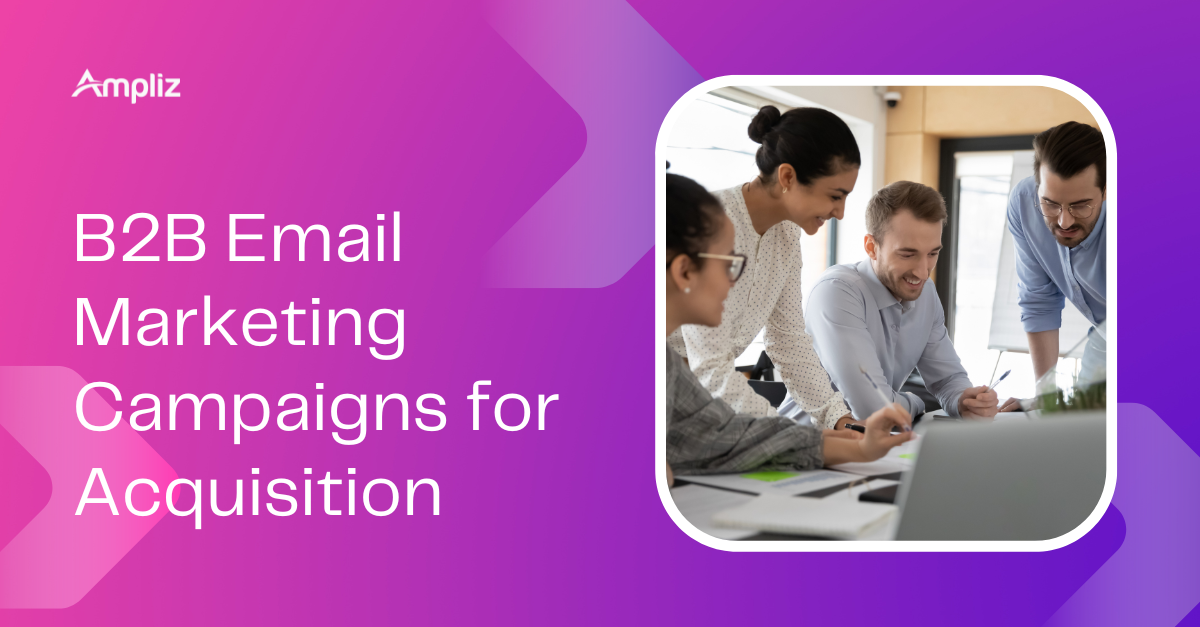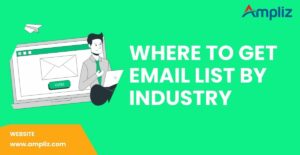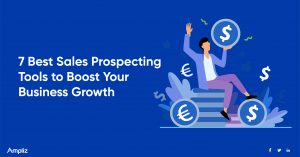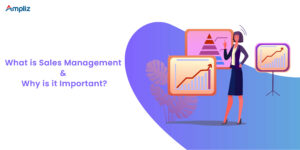Email remains a dominant force in B2B marketing. As a result, businesses from all kinds of industries tap into the power of email to engage, win back, or simply drive more customers to their brand.
The continuous success of B2B email marketing is solid proof of this. In fact, the latest email marketing statistics reveal that email is still the most effective channel to increase traffic and conversions to your website.
Do you want to learn how to make your email marketing campaigns more effective?
What important tweaks can you do to achieve more open and click-through rates?
In this article, we’ll show you great B2B email marketing campaign tips to help you generate more leads and sales.
Let’s get started.
B2B email marketing strategy for acquisition

There’s no doubt that email marketing is a great way to improve client and customer relationships. But, how do you actually make it work for you in 2022?
While email remains a good platform to connect with customers, marketing isn’t fundamentally the same as it was two decades ago. So, how can you make sure you’re making the most out of your email marketing strategy?
Building your list
Creating an email list can be overwhelming at first. How do you even get people to sign up? What type of content can you provide for them to subscribe to?
While most businesses today put all their efforts into social media, there’s a good amount of research that shows email is still the most effective way to capture leads. If you’re unsure where to start, here are some useful tips to help you get started.
What is an opt-in list?
The best way to ramp up your email marketing strategy is by leveraging the power of opt-in lists. An opt-in list is a list of people who have permitted your company to send them emails.
These emails can be product updates, which they usually get after they buy your product or service. It can also be special offer emails that can be sent regularly once you’ve new deals or products on your website.
With an opt-in list, you don’t have to compete with other businesses for a space in your target person’s inbox. You’re already there and you have access. The only thing you have to worry about is how you build an opt-in list.
People won’t just sign up their email to you without something in return. So, what can you do? There are a few effective ways but here are some of the most common:
- Lead generation form on your website
- Irresistible offers (such as discounts and deals)
- Using podcasts to increase subscribers
- Influencer marketing strategies
- Hosting webinars
How do you use lead generation methods?
But first things first, what do we mean by leads? The term “lead” refers to a person or a company showing interest in your product or service. They haven’t made a purchase yet so they aren’t customers. Your goal is to transform them into paying customers.
Lead generation techniques focus on acquiring a consistent flow of customers for service or products. When it comes to email lead generation, this strategy involves nurturing leads so they will become paying and loyal customers.
Good lead generation focuses on people, not technology. There are tons of popular crm applications that can help you boost sales. But the fact is, they’re only a tool for you to use. They aren’t actually converting your customer.
So, it’s no longer about what tech you use. It’s more about how you deal with customers and leads that differentiate you from other businesses.
Crafting subject lines
There’s not much you can do with a long email list if the emails you send never get opened. To improve your click and open rates, the next thing you should focus on is your subject lines.
Subject lines are the first few words or phrases that we see when we open our email inbox page. If they’re dull and boring, readers will most likely skip your message.
What are the top A/B testing and subject line strategies?
Email subject lines can be tricky. They may be a small part of your overall message, but they’re also the most important since they’re mainly your reader’s first impression of you. Although you want subject lines to reflect the overall idea of your message, it should be mysterious enough for the person to want to read the rest of your message.
The best way to make effective subject lines is to do A/B testing. Basically, this method requires testing two types of subject lines and analyzing which variation has better open or click rates. Once you’ve figured out which subject line delivers better outcomes, you can then use it for your email marketing campaign.
Why does personalization work?
Personalization is all about recognizing your customer and giving them attention. You should create subject lines that include data and information you have about your customers. Businesses often use their subscriber’s first name, the last item they purchased, or any other relevant data on record.
However, there’s always a downside to too much personalization. Personalization for personalization’s sake is not only bad, it’s already a very saturated technique. Starting your email with “Hi Nancy” even if that Nancy is a stranger to you is presumptuous, maybe even risky.
Also, there are data privacy issues on the line. While most people appreciate a certain level of personalization, companies must be careful how they use consumer data to create a valuable exchange between the individual and the brand. As a business, you must strike a good balance between personalization and good data privacy for your users.
Structuring your message
Just like an ordinary letter, you should also structure your email so that it hits the reader with the right emotions. Structuring allows you to highlight the most important part of your email content. Most email structures go like this: header, body, and footer.
The header is the first thing your readers will see when they receive your email. The email body is where the rest of your text goes in. This part will contain your message and the rest of the information you want your readers to know. Lastly, the footer is where you put your CTA and other messages that will get your reader to take action.
How do you make your readers feel special?
Email campaigns fail because most companies send out emails that don’t resonate with their readers. They fail to make the message personal or genuine. And most of all, they sound like corporate thugs that simply see readers as money or a name on their list. That’s not how you make readers feel valued.
When your readers feel valued, they associate you with positive emotions and you become their default buying choice. This approach can even turn many of your email readers into advocates for your company. They will not only engage with you on social media, but they will also endorse your company to other people.
How do you build trust from as early as welcoming them?
When it comes to marketing, trust and brand reputation are everything.
Pay attention to how you craft your email. As much as it needs to be personal, it also has to add value to the reader’s life. Since they’re giving you a few minutes of their time to read your email, make it worth their time.
Don’t make all your email content promotional, provide information, useful tips, or discount deals that will attach a strong positive emotion to your brand. Also, when including images in your email attachments, consider using jpg or png quality images to ensure they are clear and accessible to all.
Re-engagement campaigns for nurturing leads
So, how do re-engagement campaigns actually work? The point of re-engagement is to follow up with leads or customers who have already gone through your sales pipeline. In sales, acquiring new customers isn’t the only way to make a profit, your past customers can actually be worth investing time in as well.
Segmenting your audience
You can start your re-engagement campaign by first segmenting your users. There are many ways you can segment them. The first is by grouping them based on their current place in the sales pipeline.
For example, customers who have stopped using your app or service vs customers who have newly installed/subscribed to your app or service. Another way of segmenting is through their engagement levels, ranking them as most engaged to inactive.
This process is also called customer segmentation and it’s one of the most effective methods in implementing successful re-engagement campaigns. In fact, segmented email campaigns have 14.32% more open rates than non-segmented campaigns.
Keep your content fresh
Do you want to win back customers that have mysteriously stopped engaging with you? One of the ways to re-engage these customers is to spice up your content. Revamp how you do it and add something new. This strategy establishes your brand as the best out there. By continually putting your best content, you also avoid readers losing interest.
Use conversational, friendly language
Don’t shy away from using emojis and informal language. Many marketers don’t do this because they might think people would see them as unprofessional or improper. However, too much formality can also be a turn-off. Try to craft your message as you would talk to a friend. Let your readers know that there’s a person behind the email, not just an AI sending automated messages.
Taking advantage of automation
That being said, there’s nothing wrong with automation. As long as you’re being smart about how you’re automating your re-engagement campaigns.
Here are tips that will help you automate while still elevating your customer’s experience when engaging with your brand.
Don’t overdo the send frequency
Many people don’t like getting bombarded with emails on a regular basis. It may even be infuriating to some. While automation allows you to send as many emails to as many people as you’d like to, try to control the frequency and the volume of your messages.
A welcome message after joining your list and a weekly update email are at most the best and much tolerated. Better yet, you can also give your subscribers preference as to how many emails they’d like to receive from you. Overmailing has negative consequences such as decreased engagement, reduced visibility, and an increase in complaints.
Focus on one call to action
Try to focus on only one CTA for your email. Also, make this CTA clear and to the point. You can experiment with a variety of styles and tones but the overall message should only pertain to one important action that you want your reader to do.
Timing is everything
Scheduling your emails at regular intervals makes for a great strategy. Just like how optimal timing for social media posts is important, email timing can also affect the quality of communication you can provide to your readers.
While there are some people who only check their email once per day, there are also quite a number of people who do it several times a day. There are already different types of apps (Celoxis, HubSpot, Mailchimp, etc.) that can help you automate and send tailored automated emails to customers at whichever stage they are in your sales funnel.
Supercharge your customer acquisition and retention with B2B email marketing campaigns
Businesses that fail to realize how powerful B2B email marketing campaigns are for customer retention are being left behind. So if your company values customer interaction and branding, the time is ripe to improve your email marketing campaigns. If done right, these campaigns can be an impressive strategy for engaging and keeping customers happy with your service.
At the end of the day, email marketing is more than just generating the highest click-through and open rates. It’s an active approach to marketing that focuses on better branding and offering the highest value to customers. In the long run, it can even result in better client-customer relationships, a boost in sales, and a consistent flow of leads.



